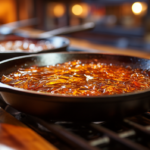Table of Contents
Discover the Fascinating Origins and Global Impact of Spice Trading from Ancient Times to Present Day
If you love cooking exotic food, you know the secret behind a delicious dish is the perfect blend of spices. But, have you ever wondered how your spice rack became so diverse? The history of the spice trade is a fascinating journey of exploration, discovery, and global impact. From the early trade routes of the 7th century to the thriving spice markets of modern-day, spices have been valued for their medicinal properties, ability to preserve food, and unique flavors. Join us on this journey through ancient civilizations, wars, and voyages of discovery, and learn how the spice trade shaped the world we live in today.
The Spice Trade: A Journey Through Time and Flavor
Spices have been an essential part of human history, influencing cultures, economies, and even wars. The spice trade is a fascinating topic that tells the story of how spices have been sought after, traded, and used for diverse purposes. Here, we explore some of the essential aspects of the spice trade:
The Origins of the Spice Trade
The spice trade has its roots in ancient times, where spices were valued for their medicinal properties and rare flavors. The first records of the spice trade date back to the 7th century when Arab traders began to import spices from the Far East to the Mediterranean region. Spice routes were established, linking China and India with the Arabian Peninsula, Persia, and Europe. Spices, such as cinnamon, ginger, and cloves, were highly prized in Europe, where their scarcity made them expensive and exclusive products.
The Global Impact of the Spice Trade
The spice trade had a significant impact on the world’s economy, driving exploration, colonization, and the creation of new markets. The European thirst for spices was one of the main reasons behind the Age of Exploration when voyagers such as Christopher Columbus and Vasco da Gama set sail to find new trade routes to the East. As Europeans colonized new territories, they introduced new spices into their culture, such as chilies in South America and vanilla in Madagascar. Today, the spice trade remains a vital industry, with countries such as India, Indonesia, and Sri Lanka being major producers of spices.
The Role of Spices in Cooking
Spices have been used in cooking for centuries, enhancing flavors, and preserving food. Each spice has a distinct taste and aroma that makes it unique and versatile. In Asia, spices such as turmeric, cumin, and coriander, are fundamental ingredients in curries and rice dishes. In Europe, spices such as nutmeg, allspice, and mustard, are used in baking and savory dishes. With the globalization of food, diverse and exotic spices have become readily available, allowing cooks to experiment with new and exciting flavors.
The Medical and Therapeutic Properties of Spices
Spices have been used in traditional medicine for their therapeutic properties for centuries. The ancient Greeks and Romans used spices such as cinnamon, ginger, and saffron for their medicinal properties. Today, researchers have found that many spices contain antioxidants, anti-inflammatory compounds, and other health-promoting substances. For example, turmeric has been shown to have anti-cancer properties, while ginger is used to The spice trade has left an indelible mark on human history, enriching our lives with new flavors, cultures, and traditions. The journey of spices from the Far East to the world’s markets has been long and fascinating, shaping the world we live in today.
Early Spice Routes and Trade in Asia
The spice trade has been a significant force in shaping world history, economy, and culture. The spice routes were first established in the 7th century, bringing black pepper, cinnamon, cardamom, and cloves from India and Eastern Asia to the Middle East and Europe. Here are some essential aspects to understand about early spice routes and trade in Asia:
- India: India was the source of most spices, as the hot and humid climate in the country provided the perfect environment for growing and cultivating seeds, roots, and leaves of a wide variety of spices. Spices were a coveted commodity in ancient India, used for medicinal, cosmetic, and culinary purposes. The spice trade in India was dominated by the powerful kingdom of Kerala, located on the Malabar coast. It maintained trade relations with the Middle East, and the first recorded instance of spices being traded to the Roman Empire was from the ports of Kerala.
- The Silk Road: The Silk Road was a network of trade routes connecting Asia and Europe, which was instrumental in the spread of culture, knowledge, and goods, including spices. The Silk Road started in China and reached the Mediterranean Sea via Central Asia, Persia, and the Middle East. The spice trade was an essential part of Silk Road commerce, and it is believed that the Chinese emperors and traders were aware of the uses and benefits of spices long before their introduction to the West.
- Technological innovations: Spice traders faced many challenges during their long journeys across land and sea, such as storms, pirates, and bandits. To overcome these, merchants devised various technological innovations, such as better ships that could withstand harsh weather conditions and carry large cargoes, and navigational tools like the astrolabe and compass that helped sailors chart their course with greater accuracy.
In conclusion, the early spice routes and trade in Asia played a crucial role in shaping the modern world. They facilitated the exchange of goods, ideas, and cultures, and impacted architecture, language, and cuisine. Before long, the spice trade extended beyond Asia to become a true global phenomenon.
Arab Traders and the Rise of Middle Eastern Spices
Spices have been a valuable commodity for centuries, and the Arab traders were instrumental in the spice trade’s development. The region’s location allowed Arab traders to control the trading routes between the East and West, making them the middlemen in the spice trade, allowing them to build vast empires.
The Rise of Middle Eastern Spices
Middle Eastern spices played a significant role in the spice trade’s growth. Spices such as saffron, cinnamon, and nutmeg were brought to the region via the Silk Road, and Arab traders started exporting them to Europe, Africa, and Asia. Arab traders then began trading with India, sourcing spices like pepper, which they then sold in the Middle East, Europe, and Africa. Some spices also came from Arab countries, such as sumac and za’atar, which are still popular in Middle Eastern cuisine today.
Trading Routes and Empires
Arab traders were able to establish empires because of their strategic location in controlling the overland trading routes between the East and West. Cities in the Middle East such as Baghdad, Cairo, and Damascus flourished, as they became centers for spice trading. Arab traders would also travel by sea, and Arab traders controlled the trade routes between the Arabian Peninsula and the Indian subcontinent.
Arab Traders and Their Influence
Besides trade, Arab traders’ influence was also felt in other areas such as religion, culture, and language. Islam spread across the globe due to Arab traders’ efforts, with traders setting up mosques and sharing their faith with people they met in their travels. Their influence in language and culture can be seen in words that have been adopted into other languages from Arabic, such as the word “orange” and “coffee.”
In conclusion, Arab traders played a critical role in the spice trade’s development, introducing Middle Eastern spices to the world and establishing empires through the control of trading routes. The influence of Arab traders, from their religion, culture, to their language, still remains present in society today. The next part of this series will explore the impact of the spice trade on Europe.
The Age of Exploration and the European Spice Trade
The 15th and 16th centuries marked the era of European exploration, and the demand for exotic spices from the East became a driving force for discovering new trade routes. The Europeans were motivated by the desire to reach the sources of spices directly and to bypass the existing Arab and Venetian monopolies. The Portuguese were the first to venture out and establish ports in India, while the Dutch and English followed in their footsteps.
The Rise of the Dutch East India Company (VOC)
The spice trade was robust, and the Dutch East India Company (VOC) became the leading spice trader. The VOC was established in 1602 and controlled trade in the East Indies, that is, modern-day Indonesia, and India. The VOC’s success was based on taking control of spice production areas, including Indonesia’s Banda Islands, which were the only place that nutmeg and mace grew.
The Significance of Spices to Europe
The spice trade influenced European history, economy, and social living. The spices were considered status symbols, and their possession was the mark of the wealthy and powerful. Spices were used to flavor food and to preserve food by covering the taste of the spoilt meat. In medieval Europe, spices were believed to have medicinal properties, and they were employed in medicines and perfumes.
The Struggle for Spice Dominance
The Portuguese, Dutch, and English competed fiercely for control of the spice trade, resulting in intense rivalry and violence. The Dutch emerged as the victors, with the British controlling some areas such as Ceylon (now Sri Lanka), and Malabar (now Kerala). The French, Danes, and Swedes also had some smaller territories, but it was the Dutch who had the most territory and power in the East Indies.
The European Age of Exploration transformed the spice trade, as the Europeans had the means of reaching the source of spices directly, producing more supplies for themselves, and earning fortunes. They established trading posts, colonies, and monopolies, eventually dominating the spice trade. The competition between various European powers resulted in a volatile business atmosphere, with the Dutch emerging supreme. The spice trade shaped European economics, cuisine, and society, and brought rich flavors and new cultures into European cuisine.
Spice Wars, Innovation, and the Industrial Revolution
The spice trade reached a new level of intensity in the 16th century as European powers vied for control of lucrative spice markets. New technological innovations and industrialization further transformed the trade, leading to the development of global spice production and consumption.
The Dutch East India Company
In the 17th century, the Dutch East India Company emerged as the dominant European power in the spice trade. The company’s monopoly on the spice islands of Indonesia, coupled with advanced shipping and navigation technology, allowed them to control the world’s supply of spices, particularly nutmeg, mace, and cloves.
The Spice Wars
Competing European powers began to challenge the Dutch monopoly, leading to a series of wars over control of the spice trade. The Portuguese and British in particular were able to gain footholds in key spice-producing regions, such as India and Sri Lanka, leading to increased competition and innovation in the industry.
Innovations in Spice Transportation and Preservation
The rise of industrialization in the 18th and 19th centuries brought new developments in transportation and preservation technologies that allowed for even greater global distribution of spices. Steamships, trains, and canning methods made it possible to transport and store spices more efficiently, leading to a reduction in prices and increased access to exotic flavors.
The Impact of the Industrial Revolution on the Spice Trade
The Industrial Revolution completely transformed the spice industry, making it more efficient, affordable, and accessible to the masses. Spices were no longer luxury products reserved for the elite, but rather became widely available as food became more industrialized and global trade expanded.
While the spice trade started as a regional exchange between traders in the early days to the golden age of the trade, the industry transformed, and still holds a significant position in today’s global trade industry.
Conclusion
The history of the spice trade is a story of adventure, exploration, and innovation. For centuries, spices were valued for their medicinal properties, ability to preserve food, and unique flavors, making them an essential commodity traded across the globe. From ancient times to modern-day, the spice trade has shaped the world we live in today. It connected cultures, fostered economic growth, and sparked technological advancements that transformed societies. As we reflect on the journey of spices, we realize how essential these exotic ingredients are to our daily lives. The spice trade will continue to be a significant part of our culinary heritage as we explore new ways to incorporate spices into our cuisine.









